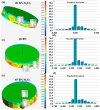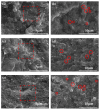DIW-Printed Thermal Management PDMS Composites with 3D Structural Thermal Conductive Network of h-BN Platelets and Al2O3 Nanoparticles
- PMID: 38891437
- PMCID: PMC11174620
- DOI: 10.3390/polym16111491
DIW-Printed Thermal Management PDMS Composites with 3D Structural Thermal Conductive Network of h-BN Platelets and Al2O3 Nanoparticles
Abstract
Electronic devices play an increasingly vital role in modern society, and heat accumulation is a major concern during device development, which causes strong market demand for thermal conductivity materials and components. In this paper, a novel thermal conductive material consisting of polydimethylsiloxane (PDMS) and a binary filler system of h-BN platelets and Al2O3 nanoparticles was successfully fabricated using direct ink writing (DIW) 3D printing technology. The addictive manufacturing process not only endows the DIW-printed composites with various geometries but also promotes the construction of a 3D structural thermal conductive network through the shearing force during the printing process. Moreover, the integrity of the thermal conductive network can be optimized by filling the gaps between the BN platelets with Al2O3 particles. Resultingly, the configuration of the binary fillers is arranged by the shearing force during the DIW process, fabricating the thermal conductive network of oriented fillers. The DIW-printed BN/Al2O3/PDMS with 45 wt% thermal conductive binary filler can reach a thermal conductivity of 0.98 W/(m·K), higher than the 0.62 W/(m·K) of the control sample. In this study, a novel strategy for the thermal conductive performance improvement of composites based on DIW technology is successfully verified, paving a new way for thermal management.
Keywords: Al2O3; boron nitride; thermally conductive composites; three-dimensional thermal network.
Conflict of interest statement
The authors declare no conflicts of interest.
Figures









Similar articles
-
Controlling Shear Rate for Designable Thermal Conductivity in Direct Ink Printing of Polydimethylsiloxane/Boron Nitride Composites.Polymers (Basel). 2023 Aug 21;15(16):3489. doi: 10.3390/polym15163489. Polymers (Basel). 2023. PMID: 37631546 Free PMC article.
-
Enhanced the Thermal Conductivity of Polydimethylsiloxane via a Three-Dimensional Hybrid Boron Nitride@Silver Nanowires Thermal Network Filler.Polymers (Basel). 2021 Jan 13;13(2):248. doi: 10.3390/polym13020248. Polymers (Basel). 2021. PMID: 33450963 Free PMC article.
-
Hydrogen Bond-Regulated Boron Nitride Network Structures for Improved Thermal Conductive Property of Polyamide-imide Composites.ACS Appl Mater Interfaces. 2018 May 16;10(19):16812-16821. doi: 10.1021/acsami.8b03522. Epub 2018 May 2. ACS Appl Mater Interfaces. 2018. PMID: 29642703
-
Thermal Conductivity and Cure Kinetics of Epoxy-Boron Nitride Composites-A Review.Materials (Basel). 2020 Aug 17;13(16):3634. doi: 10.3390/ma13163634. Materials (Basel). 2020. PMID: 32824496 Free PMC article. Review.
-
Thermal Conductivity Enhancement of Polymeric Composites Using Hexagonal Boron Nitride: Design Strategies and Challenges.Nanomaterials (Basel). 2024 Feb 7;14(4):331. doi: 10.3390/nano14040331. Nanomaterials (Basel). 2024. PMID: 38392704 Free PMC article. Review.
References
-
- Chen C., Yu H.-T., Feng Y.-Y., Feng W. Polymer Composite Material with both Thermal Conduction and Self-healing Functions. Acta Polym. Sin. 2021;52:272–280.
-
- Cho E.-C., Chang-Jian C.-W., Hsiao Y.-S., Lee K.-C., Huang J.-H. Three-dimensional carbon nanotube based polymer composites for thermal management. Compos. Part A Appl. Sci. Manuf. 2016;90:678–686. doi: 10.1016/j.compositesa.2016.08.035. - DOI
-
- Fang H., Chen A., Zhang L., Chen S., Wu F., Chen H. Synergistic enhancement of thermal conductivity in thermal interface materials by fabricating 3D-BN-ZnO scaffolds. Polym. Eng. Sci. 2022;62:1641–1649. doi: 10.1002/pen.25952. - DOI
-
- Fang H., Zhang X., Zhao Y., Bai S.-L. Dense graphene foam and hexagonal boron nitride filled PDMS composites with high thermal conductivity and breakdown strength. Compos. Sci. Technol. 2017;152:243–253. doi: 10.1016/j.compscitech.2017.09.032. - DOI
-
- Fu H., Huang Y., Liu Y., Li F., Gai Z., Jiang Y., Gao X., Zhuang J., Sun J., Xu H., et al. Enhanced thermal conduction of hybrid filler/polydimethylsiloxane composites via a continuous spatial confining process. Compos. Sci. Technol. 2022;226:109536. doi: 10.1016/j.compscitech.2022.109536. - DOI
Grants and funding
LinkOut - more resources
Full Text Sources

